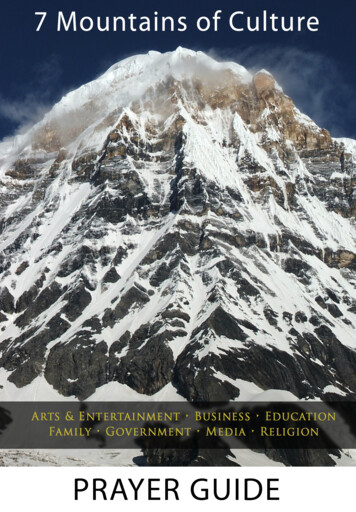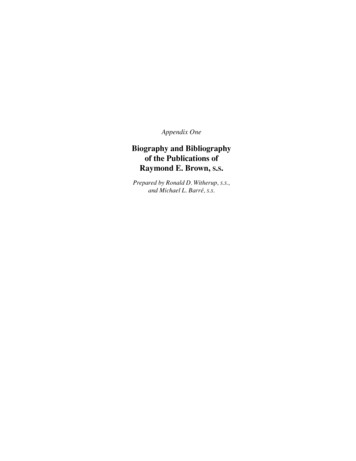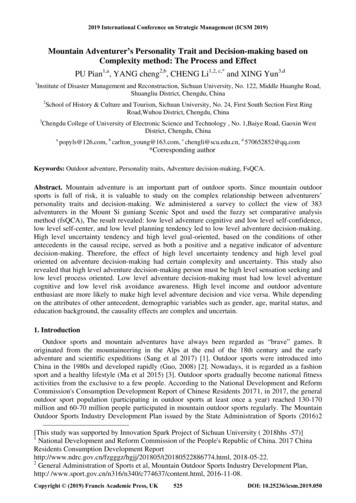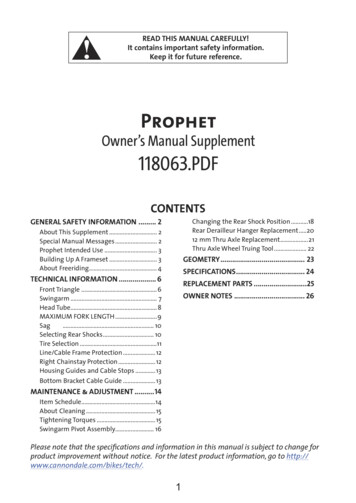
Transcription
GEOLOGICAL SURVEY CIRCULAR 646Origin of theBrown Mountain Lightin North Carolina
Origin of theBrown Mountain Lightin North CarolinaBy George Rogers MansfieldGEOLOGICALSURVEYWashington 1971CIRCULAR646
United States Department of the InteriorROGERS C. B. MORTON, SecretoryGeological SurveyW. A. Radlinski, Acting DirectorFree on application to the U.S. Geological Survey, Washmgton, D.C 20242
Brown Mountain--in the Blue Ridgecountry of western North Carolina--isthe stage and setting for the intermittent performances of the "mysteriouslights" that have provoked legend andsong since the beginning of the century.In 1922, responding t0 a general interest in the lights, tt U.S. GeologicalSurvey sent geologist George R.Mansfield to Brown Mountain to undertake a thorough investigation of thereported phenomenon. Mansfield's method of study and his conclusions werereleased to the press in 1922. Becauseof the present interest in Brown Mountain shown by visitors to this scenicarea, George R. Mansfield's report tothe press is reproduced here just as itwas written a half century ago.
CONTENTSPageGovernment investigations made--Aid receiv-ed in thisinvestigation-----------------Topography of Brown Mountain----Geologic features---------------Records of earlier observations-Review of earlier observations--Places of observation-----------Nature and appearance of thelight--------------------------1122256Proposed explanations-----------The investigation in 1922-------Methods employed------------Observations at Loven's-----Observations at GingercakeMountain------------------Observations at gure 1.Map of Brown Mountain region, N.C., illustrating or1g1n of"Brown Mountain lights"------------------------------------v3
Origin of the Brown Mountain light in North CarolinaBy George Rogers Mansfield1after another local investigatorfailed to discover their origin, themystery seemed to grow deeper. Finally Senators Simmons and Overman prevailed upon the Geological Survey tomake a second and more thorough investigation of these puzzling lights.The present writer, to whom the taskof making this investigation was assigned, spent 2 weeks near BrownMountain in March and April 1922 andtook observations on seven evenings,on four of them until after midnight,from hillsides that afforded favorable views of the lights. The resultsof the work are reported here.GOVERNMENT INVESTIGATIONS MADEFor many years "mysterious lights"have been seen near Brown Mountain,in the northern part of Burke County,N.C., about 12 miles northwest ofMorganton. Some have thought thatthese lights were of supernaturalorigin; others have dreamed that theymight indicate enormous mineral deposits; and many who have not had suchvisions have looked upon them as anatural wonder that lent interest toall vacation trips to the region.In October 1913 at the urgent request of Representative E. Y. Webb, ofNorth Carolina, a member of the U.S.Geological Survey, D. B. Sterrett, wasAID RECEIVED IN THIS INVESTIGATIONsent to Brown Mountain to observethese lights and to determine theirThe writer gratefully acknowledgesorigin. After a few days investigation his indebtedness to Messrs. R. T.Mr. Sterrett declared that the lightsClaywell, A. M. and Charles Kistler,were nothing but locomotive headlights and H. L. Millner, of Morganton, whoseen over the mountain from the neigh- gave him much information and assistboring heights. This explanation wased him in many ways in his investitoo simple and prosaic to please anygation. Joseph Loven, of Cold Spring,one who was looking for some superand H. C. Martin, of Lenoir, accomnatural or un4sual cause of the lights, panied him on some of the evenings ofand when they were seen after theobservation. G. E. Moore, of Lenoir,furnished valuable information. F. H.great flood of 1916, while no trainsMay, of Lenoir, organized a party towere running in the vicinity, evenaccompany him to the summit of Brownsome of those who had accepted Mr.Sterrett's explanation felt compelledMountain and generously rendered muchto abandon it.valuable aid. Monroe Coffey andAs time went on, the interest in theTheodore Crump, of the U.S. Forestlights became more general, and as one Service, extended to him the hospitality of their camp on Brown1rssued in 1922 as Press NoticeMountain and joined in theinvestigation.14328.1
Drs. W. J. Humphreys and HerbertLyman and Mr. C. F. Talman, of theU.S. Weather Bureau, obligingly furnished correspondence and unpublishedmanuscript relating to the BrownMountain light, and W. W. Scott, ofWashington, kindly lent a scrapbookcontaining copies of his own andother published articles relating toBrown Mountain.The writer is also indebted to hiscolleagues of the Geological Surveyfor helpful suggestions and discussions, particularly to Arthur Keithfor information about the geology ofthe Brown Mountain region and to R. H.Sargent, J. B. Mertie, Jr., and A. C.Spencer for aid in the interpretationof instrumental observations.of the mountain is composed of theCranberry Granite, a rock which alsounderlies many square miles on thenorth side of the Blue Ridge.The Caldwell Power Co. has drilleda series of holes, 50 to nearly 100feet deep, along the lower part ofthe east slope of Brown Mountain preliminary to the location of a tunnel.Through the kindness of H. L. Millne an officer of the company; the writerwas permitted to examine the corestaken from these holes. Most of themconsisted of ordinary granite,· thougha few included masses of rock ofother kinds. The men who surveyed theline for the tunnel reported localmagnetic attraction amounting to adeflection of about 6 , but thoughrepresentative pieces of all the different kinds of cores were presentedto the compass needle, they producedno noticeable effect. Dip-needletests made to determine magnetic conditions at Brown Mountain gave readings of 41 0 , which is slightlygreater than those made at Loven's orat Gingercake Mountain (40 ) but lessthan those made at Blowing Rock (43 )and at the Perkins place, near Adako(45 ).TOPOGRAPHY OF BROWN MOUNTAINThe shape and general elevation ofBrown Mountain are shown on the accompanying map. Its eastern ridgeforms part of the boundary betweenBurke and Caldwell Counties. Its topis plateaulike and reaches a maximumelevation of about 2,600 feet. It ispartly cut away by southward-flowingbranches of Johns River and is separated from more intricately carveduplands on the northwest, north, andnortheast by Upper and Wilson Creeksand their tributaries. Seen from adistance from almost any direction,Brown Mountain appears as a ridgehaving a nearly even skyline. (Seemap , fig 1. )RECORDS OF EARLIER OBSERVATIONSSo far as the writer is aware thefirst published account of the lightwas given in a dispatch from LinvilleFalls to the Charlotte Daily Observer,dated September 23, 1913, in whichits discovery is credited to membersof the Morganton Fishing Club, whosaw.it "more than two years ago" butwho were "laughed at and accused ofseeing things at night." This accountis quoted in part below:· . The mysterious light that is seenjust above the horizon almost everynight from Rattlesnake Knob, nearCold Spring, on the Morganton road* * * is still baffling all investigators * * *With punctual regular-GEOLOGIC FEATURESThe geologic features of the BrownMountain region are the southwardextension of the features seen farther north, which are described andmapped in the Cranberry-folio, No. 90of the series of folios of the Geologic Atlas of the United States.There is nothing unique or unusual int e geology of Brown Mountain. Most2
iN .PROFILE FROM STA. B ON UNE IS, SHOWING METHOD OFLOCATION OF LIGHT BY USE OF A VERTICAL ANGLE.ELEVAT.t:lo\!. VERT1CA/. ANISLC,. ANO CVRVAnJRE !EO 4iT/Ma!;. 1SKETCH OF BROWN MOUNTAIN FROM STA.A NEAR LOVENS.NOT hOW' THE VIEW AT THE' RltSHT IS CUT OFF.w--------- 6 :0Z468- "-4-------------10 MILESl .l.i---dd----4Figure 1.--Map of Brown Mountain region, N.C., illustrating origin of11Brown Mountain lights. 11
ity the light rises in a southeasterlydirection from the point of observation just over the lower slope ofBrown Mountain, first about 7:30 p.m.and again at 10 o'clock. It looks muchlike a toy fire balloon, a distinctball, with no atmosphere about it.* * * It is much smaller than thefull moon, much larger than any starand very red. It rises in the fardistance from beyond Brown Mountain,which is about 6 miles from Rattlesnake Knob, and after going up a shortdistance, wavers and goes out in lessthan 1 minute * * *· It does not always appear in exactly the same place,but varies what must amount in thedistance to several miles. The lightis visible at all seasons, so Mr.Anderson Loven, an old and reliableresident testifies * * *· There seemsto be no d6ubt that the light risesfrom some point in the wide, levelcountry between Brown Mountain and theSouth Mountains, a distance of about12 miles, though it is possible thatit rises at a still greater distance."In this article in the CharlotteDaily Observer, the discovery of thelights is assigned to a date "morethan 2 years ago," but conversationwith B. S. Gaither, of Morganton, whoparticipated in the fishing partymentioned, and who was the one whofirst saw the lights, elicited thefact that they were observed in 1908or 1909. Rev. C. E. Gregory, who in1910 built a cottage on the littleknoll near Loven's Hotel at ColdSpring, presumably the RattlesnakeKnob referred to, was, according tolocal oral accounts, the first to givemuch attention to the lights and tobring them to public notice.H. L. Millner, an engineer living atMorganton, states that he did railroadsurveying all through the mountainsnorth of Brown Mountain in 1897, 1899to 1903, and in 1905. He afterwardspent many summer vacations in thosemountains but says that he never sawthe lights and never heard of themuntil 1910. Similar testimony isgiven by Rev. Albert Sherrill, whoserved two churches in the countryabout Brown Mountain. In a letter toDr. W. J. Humphreys dated January 25,1922 he says:"For 4 years I traveled the roads tothese churches and visited in thehomes of the people all about thismountain. I held revival services dayand night, which gave me a chance ofobservation at night. This was from1909 to 1912, inclusive. At no timein all these years did I see a lightor hear of one * * *Two yearsafter I left there was the first Iever heard of it."On the other hand, Col. Wade H.Harris, editor of the Charlotte DailyObserver, from which the first description of the light, quoted above,was taken, states in a letter datedOctober 2, 1921, addressed to SenatorSimmons that "there is a record thatit (the light) has puzzled the peoplesince and before the days of theCivil War." R. T. Claywell, ofMorganton, says that people used tocome to Burke County 60 years ago tosee the lights. Joseph Loven, of ColdSpring, says that he noticed thelights as early as 1897, when hemoved to his present home by Loven'sHotel, but that he had heard nothingabout them and paid no attention tothem until Mr. Gregory came, in 1910.In October 1913, Mr. Sterrett ofthe U.S. Geological Survey made hisinvestigation, as a result of whichhe decided that the lights were locomotive headlights. He did not visitRattlesnake Knob but went unaccompanied to the Brown Mountain region,where he made his observations.A newspaper article on the lights,by W. W. Scott, published November10, 1915, aroused much local interestand started newspaper discussions, asa result of which several expeditions,made up of local observers, visited4
of Rattlesnake Knob, yet during thatperiod the lights were reported to beseen as usual. This fact showed thatthe Brown Mountain lights could notbe ascribed solely to locomotiveheadlights.Late in 1919 the question of theorigin of the Brown Mountain lightwas brought to the attention of theSmithsonian Institution and referredto the U.S. Weather Bureau. Descriptions given in letters from trustworthy observers led Dr. W. J.Humphreys, of that Bureau, to decidethat the light was an electrical discharge analogous to the "Andes light"of South America. This Andes lig tand its possible elation to theBrown Mountain light became the subject of a paper presented by Dr.Herbert Lyman before a meeting of theAmerican Meteorological Society heldat the Weather Bureau in Washingtonin April 1921. Soon thereafter thesuggestions of the physicists of theWeather Bureau were embodied in abulletin on the Brown Mountain lightissued by the National GeographicSociety, in which this light was represented as a manifestation of theAndes light. Neither the WeatherBureau nor the National GeographicSociety, however, had sent an investigator to Brown Mountain to observethe lights.Brown Mountain early in the winter of'1915, and in the spring of 1916 andattempted to determine the characterand source of the lights. The membersof these expeditions made some interesting observations but did not satisfactorily achieve their object.Mr. H. C. Martin, of Lenoir, statesthat on April 11, 1916, he and Dr.L. H. Coffey organized an expeditionto study the Brown Mountain light.Mr. Martin's party went to AdamsMountain. Dr. Coffey's party went toBrown Mountain. Each party subdividedinto several groups and signals werearranged that whichever group firstsaw the light should. fire a pistol.Dr. Coffey's party saw the light overthe summit of Adams Mountain at 8:10and again at 9:45, over a point somewhat farther south. About 5:10 a.m.they saw the light again over thesouth end of Adams Mountain. None ofthese appearances was seen by Mr.Martin's party, but about 11:52 hisparty saw two lights (floatingglobes), "apparently about the sizeof ordinary street lamps of Lenoirseen from the distance of about 1mile," flash out among the trees onthe east side of Brown Mountain aboutone-eighth of the distance down fromthe summit. These lights moved horizontally southeastward, floating inand out of the ravines, along themountainside past a dead pine tree inMr. Martin's line of sight for a distance estimated at 2 miles. Then theyreturned northwestward about halfthat distance, again passing the lineof the dead tree. At 12:13 the lightsdisappeared as suddenly as they came.These lights were not seen by Dr.Coffey's party.In the summer of 1916, a greatflood swept down the valley ofCatawba River, washing out bridgesand railroad tracks and suspendingall railroad traffic in and aboutMorganton, so that for several weeksno trains came within 40 or 50 miles. REVIEW OF EARLIER OBSERVATIONSThose who have -seen the lights fromthe.south or east may with justicecontend that no locomotive headlightscan be seen to the north and northwest. A good topographic map, howeve shows many roads on which an automobile headlight might intervenebetween an observer and Brown Mountain in such a way as to give muchthe same effect that one would get inviewing it over the mountain fromLoven's or Blowing Rock.There are two buildings on the summit of Brown Mountain. One of these51
is owned by the Brown Mountain Cluband the other is a Forest Servicestation. Lights in these and thefires of campers are the only lightsknown to originate on Brown Mountainand are the only lights that havebeen seen on the mountain by observers on the mountain. There are alsosome buildings on the southern spursof Brown and Adams Mountains. Seenfrom favorable viewpoints these mightfurnish lights that could be interpreted as manifestations of the BrownMountain light.For some years there have been lumber camps in Upper Creek west ofBrown Mountain. Some of the buildingsat these camps are on the sides ofthe valley or on Ripshin Ridge.Viewed from favorable positionslights in these buildings might beascribed to the Brown Mountain light.Rare electrical discharges similarto those reported from western Virginia may take place on Brown Mountain or on other ridges on the BlueRidge front, but they could havenothing in common with the ordinaryBrown Mountain light either inappearance or in regularity ofoccurrence.The lights seen by Mr. Martin fromAdams Mountain can probably not besatisfactorily explained after solong a lapse of time. There is noreason to attribute to them supernatural or unusual origin, and theycannot be explained as due to mirage,which is Mr. Martin's idea. The suggestion that they might have beencaused by moonshiners carrying lanterns has been rejected because ofthe roughness of the east side ofBrown Mountain and because of thedistance that the lights seemed totravel in 20 minutes. They might bedue to fireflies flying relativelynear Mr. Martin yet appearing undulylarge because his eyes were focusedon the distant hillside, the appearance of going in and out of ravinesbeing due to intermittence in thelights, but H. S. Barber, an entomologist of the Division of Insectsof the National Museum, to whom thematter was referred, states that thisexplanation, though possible, isimprobable, chiefly because of thelateness of the hour of observation.PLACES OF OBSERVATIONIn the article published in theCharlotte Daily Observer in September1913, it was stated that the lightswere first observed from a place nearLoven's Hotel, at Cold Spring, and aslate as November 1915, Mr. Scott, inhis newspaper article cited above,states that "Mr. Loven's is the onlyplace from which has been seen themysterious light that rises overBrown Mountain." By the spring of1916, however, the lights were beingobserved from several places nearLenoi . More recently they were seenfrom Blowing Rock, which is visitedby many tourists, who find accommodations at several flourishing hotels.The lights furnish one of the manyattractions afforded by this remarkably well situated and delightfullittle town. Among the other localities from hich the Brown Mountainlights are said to have been seenare the slopes of Gingercake Mountain,about a mile and a half southwest ofCold Spring, and the toll gate on theYonahlossee road, on the south slopeof Grandfather Mountain. It is alsoreported that they have been seenfrom Morganton and from other pointsin the valley southeast of BrownMountain.It is significant that, though manypersons have from time to time campedon Brown Mountain and have spentnights watching for the lights, yet,so far as the writer has been able toascertain, no one has actuallyobserved the light on Brown Mountainwhen he himself was on that mountain,6
but, as in Dr. Coffey's observation,it has been seen from Brown Mountainas apparently over Adams Mountain orsome hills farther south. MonroeCoffey and Theodore Crump, of theU.S. Forest Service, have spent manynights in and about Brown Mountainand have built a fire-control stationon the summit of the mountain nearthe cabin of the Brown Mountain club,but at the time of the writer's visitneither of them had ever seen theBrown Mountain light."We were impressed with the following facts: The region about BrownMountain and between our location andthe mountain is a wild, practicallyuninhabited mountain region--a confusion of mountain peaks, ridges, andvalleys. Viewing the lights from afixed position our estimate of theirlocation was most inexact; the varying color (almost a white, yellowish,reddish) may have been due to mist inthe atmosphere; the view of the lightswas a direct one and not a reflection;there seemed to be no regularity intheir time of appearance; they camesuddenly into being, blazed steadily,and as suddenly disappeared; theyappeared against the sky and notagainst the side of the mountain."Others who have seen this phenomenon make very different reports oftheir observation; and some who haveseen it several times report thatthey have seen it in varying fashion;sometimes the light appears stationary (as was uniformly the case whenI saw it); sometimes it appears tomove rapidly--upward, downward,horizontally."Rev. C. E. Gregory is reported tohave noted upon one occasion that thelight appeared like a ball of incandescent gas, in which a seethingmotion could be observed.NATURE AND APPEARANCE OF THE LIGHTIn his letter to Senator Simmonsalready cited, Colonel Harris writesas follows concerning the light:"It is a pale white light, as oneseen through a ground glass globe,and there is a faint, irregularlyshaped halo around it. It is confinedto a prescribed circle, appearingthree or four times in quick succession, then disappearing for 20 minutes or half an hour, when it repeatswithin the same circle."Prof. W. G. Perry, of the GeorgiaSchool of Technology, in a letterdated December 15, 1919, addressed toDr. C. G. Abbot, of the SmithsonianInstitution, describes the light asseen from the Cold Spring locality asfollows:"We occupied a position on a highridge. Across several interveningridges rose Brown Mountain, some 8miles away. After sunset we began towatch the Brown Mountain direction.Suddenly there blazed in the sky,apparently above the mountain, nearone end of it, a steadily glowingball of light. It appeared to beabout 10 above the upper line of themountain, blazed with a slightlyyellow light, lasted about half aminute, and then abruptly disappeared.It was not unlike the "star" from abursting sky rocket or Roman candle,though brighter * * *PROPOSED EXPLANATIONSMany explanations of the BrownMountain lights have been offered.The principal ones that have come tothe notice of the writer are brieflyoutlined below.1. Will-o'-the-wisp: A light calledwill-o'-the-wisp is sometimesseen over marshy places and issupposed to be due to the spontaneous combustion of marsh gas.There are, however, no marshyplaces on or about Brown Mountain, and the lights seen by the7
2.3.4.5.writer could not be ascribed tosuch a cause.Phosphorus: It has been suggestedthat the lights may be caused insome way by the element phosphorus. Phosphorus, however, is soeasily oxidized that it does notoccur in the free state. It isusually locked up in stable andrelatively insoluble chemicalcompounds and therefore cannotbe a cause of the Brown Mountainlight.Phosphorescence (fox fire): Someorganic bodies, such as stumpsor logs, become luminous orphosphorescent by slow oxidationand combustion in the course oftheir decay. Such lights are toofeeble to be seen at a distanceof several miles and are unlikethe lights seen by the writer.Radium emanations: The late F. H.Hossfield is reported to havefound a piece of pitchblende, anore of radium, near the southwest end of Brown Mountain, andsome therefore think that BrownMountain may contain a largebody of radium ore, which mightby emanation produce the observed lights. So far as thewriter has been able to learn,the material that was supposedto be pitchblende was never soidentified by actual tests, andthe place where it was found isnot accurately known. The specimen itself has been lost; butpitchblende, even if it occurredin large deposits, could notgive rise to lights like thoseseen over Brown Mountain. Noknown r dium ore shows that kindof luminosity.Chemical reaction between hydrogensulfide aad lead oxide: In aletter received from Mr. E. C.Ivey, of Hickory, it is suggestedthat the lights may be so caused,and it is stated that bothhydrogen sulfide and lead oxideoccur in Brown Mountain and thathydrogen sulfide will ignite inth presence of lead oxide. Sulphur springs occur on the westside of Brown Mountain and leadprospects are reported on theeast side, but the possibilitythat there is any direct relation between them is so slightas to be highly improbable.6. "Blockade" (illicit) stills: Manystills have been operated by"moonshiners" in the vicinity ofBrown Mountain. A man who claimsto have been an eyewitnessstates that screens are placedabout these stills to shut offthe light from the fires butthat from time to time the firesare raked out and the covers ofthe stills removed, so that theclouds of steam which arise fromthem are illuminated by thefires below. The "moonshiners"are also said to use lights forsignaling. It is possible thatthe light with "seething motion"seen by Mr. Gregory may havebeen of this origin, but thereare not enough such stills andthey probably would not be insufficiently continuous operation to produce lights in thenumber and in the regularity ofappearance of those seen atBrown Mountain.7. St. Elmo's fire: St. Elmo's fireis a brushlike, luminous, electrical discharge that sometimestakes place from masts, lightning conductors, and otherpointed objects, especiallyduring thunderstorms. In hiscorrespondence with Messrs.Clark and Perry, the trustworthyobservers already mentioned, Dr.C. G. Abbot, of the SmithsonianInstitution, suggested that theBro'ln Mountain light may be dueto St. Elmo's fire, but there8
clear sky.Dr. Guy Hinsdale, in theScientific Monthly for September1919, reports that in westernVirginia, where there are "numerous parallel ridges withintervening deep and narrow valleys, it occasionally happensthat an electric discharge takesplace from the summits of theseridges into the atmosphere.There is nothing audible, butmerely the sudden glow of thehigher clouds in the dark. night:'The appearance of the Andeslight, as shown in illustrationsgiven by Dr. Knoche and in theaccounts of it already cited, istotally different from that ofthe Brown Mountain light as seenby the writer during his investigation or as described byothers, and there appear to beno geologic conditions at ornear Brown Mountain that wouldproduce electrical dischargesthere rather than at BlowingRock or Grandfather Mountain orany other prominent point inthis region.9. Mirage: Mr. H. C. Martin, in theLenoir Topic for April 19, 1916,and afterward in conversationwith the writer, has suggestedthat the lights may be due tomirage. He thinks that air currents of different temperatureand density may produce betweenthem reflecting surfaces, fromwhich bright stars or otherlights might be reflected insuch a way as to produce theeffects commonly seen. Accordingto this explanation the waveringof the reflecting surface wouldcause the sudden appearance,wavering, and disappearance ofthe light.A mirage is a phenomenon ofthe daytime rather than of thenight. The requisite conditionsseems to be little in common between the lights seen by thewriter and St. Elmo's fire asusually described. In a secondletter to Dr. Abbot, datedJanuary 9, 1920, Professor Perrystates the case clearly when hesays, "My own impression of St.Elmo's fire and similar phenomena was that it occurred at theextremity of some solid conductor instead of occurring, as inthe case of the Brown Mountainlights, in the air, at a greatdistance from any object."8. Andes light: The name "Andeslight," according to informationfurnished to the writer by Dr.Herbert Lyman, of the U.S.Weather Bureau, is given to avery striking luminous dischargeof electricity seen over thecrest of the Andes in Chile,where ordinary thunderstorms arealmost unknown. The mountainpeaks appear to act as giganticlightning rods, between whichand the clouds silent dischargestake place on a vast scale.The principal writer on theAndes light is Dr. WalterKnoche, who was for severalyears director of the CentralMeteorological and GeophysicalInstitute at Santiago, Chile,and who says that he has seenthis light at distances greaterthan 300 miles. Most of the discharges appear to produce glimmering lights that have circularborders. The flashes are brightat their starting points butdiminish rapidly in intensityand then slowly disappear. Thearea of this silent discharge isat first small and lies over themain cordillera, but it soon extends far over the zenith andsometimes reaches over the coastcordillera and out to sea. Thephenomena is best seen in a9
"Conclusions."11. Automobile headlights: Powerfulheadlights on automobiles havebeen suggested as a source ofthe Brown Mountain light. Theobjection made to this suggestion is similar to that made tothe suggestion that they arecaused by locomotive headlights,and it fails for the same reasons. When seen at long distances the two kinds of headlights behave in a similar manner. Of the 23 lights recordedby instrumental observation inthe investigation here reported11 were probably automobileheadlights.are that the air must be stilland that the lower layers, heated by radiation from the underlying surface, must become lessdense than the overlying layersand yet be unable to escape.With the least disturbance ofthese unstable conditions theoverheated air suddenly "spills"upward and mirage disappears.The conditions in a mountaingorge such as that of WilsonCreek east of Brown Mountain areentirely unfavorable to mirage,for as soon as the lower airbecomes warmed it may escape upthe surface slopes, and at evening there is likely to be adownward draft of cool air fromthe neighboring uplands. Yet Mr.Martin, in seeking in air currents of different temperatureand density an explanation ofthe light, has hit upon what thewriter believes to be a fundamental element in the problem,as will be more fully explainedbelow.10. Locomotive headlights: D. B.Sterrett, of the U.S. GeologicalSurvey, who investigated thelight on October 11, 1913, notedthat the headlights of westboundSouthern Railway locomotivescould be observed from BrownMountain and that they werebrilliant enough to be seen inthe same straight line fromLoven's place, 6 miles beyond.He checked on the train schedules and concluded that locomotive headlights were "beyonddoubt" the cause of the BrownMountain light. Objection tothis view has been raised on theground that a locomotive headlight casts a beam, which, likethat of a searchlight as frequently seen, can be readilyidentified. This objection isconsidered under the headingTHE INVESTIGATION IN 1922METHODS EMPLOYEDAfter a conference in Morgantonwith men who are familiar with thelights the writer set out to take observations at the place near Loven'sHotel and at other places from which,according to reports, the lightscould be seen, Brown Mountain itselfbeing one of the places. The instr
t e geology of Brown Mountain. Most 2 of the mountain is composed of the Cranberry Granite, a rock which also underlies many square miles on the north side of the Blue Ridge. The Caldwell Power Co. has drilled a series of holes, 50 to nearly 100 feet deep, along the lower part










